American Lotus, Water Lotus, Water Chinquapin, Yellow Lotus - Nelumbo lutea
|
Nelumbo lutea - American Lotus, Water Lotus, Water Chinquapin, Yellow Lotus. Nelumbonaceae - the Lotus-lily family - is monotypic - Nelumbo is the only genus in the family. There are two species of this aquatic plant, both found in the United States. Nelumbo nucifera - Sacred Lotus - is an introduced species, and has white or pink tepals, and has naturalized as a garden escapee in a number of states in the eastern half of the U.S., tending toward the southern part. Nelumbo lutea is native to the United States, and has a much wider distribution than its introduced cousin. It has pale yellow tepals, so pale in some cases that they appear to be white. The tepals fall off sooner on N. nucifera than they do on N. lutea.
The Lotus name is shared with another unrelated plant genus in the Fabaceae (Pea) family, which goes by the common name Trefoil (although there are plants commonly called Trefoil which are not in Lotus.) Bird's-foot Trefoil is probably the most commonly known species in Lotus.
Nelumbo lutea - American Lotus - is threatened or endangered in Michigan, New Jersey, and Pennsylvania.
Found in:
AL, AR, CA, CT, DE, FL, GA, IA, IL, IN, KS, KY, LA, MA, MD, ME, MI, MN, MO, MS, NC, NE, NJ, NY, OH, OK, PA, SC, TN, TX, VA, WI
Leave comments on Nelumbo lutea at this link. | 
Distribution of Nelumbo lutea in the United States and Canada:

Blue=Native; Grey=Introduced
Map from USDA Plants Database:
USDA, NRCS. 2017. The PLANTS Database (http://plants.usda.gov, 03 Apr 2025). National Plant Data Team, Greensboro, NC 27401-4901 USA.
Search Our Database: Enter any portion of the Scientific, Common Name, or both.
Do a general Google search of the entire site:
#ad
 Follow USWildflowers on Twitter
#ad
| | Site: Riverwalk, Amnicola Marsh, Hamilton County, TN Date: 2013-July-15 | Photographer: Gerald C. Williamson
Nikon D7000
Tamron SP 90MM f/2.8 AF Macro | | The tepals of American Lotus become more petal-like closer to the center of the blossom, where they surround the large seed receptacle. | | 
| | Site: Riverwalk, Amnicola Marsh, Hamilton County, TN Date: 2013-July-20 | Photographer: Gerald C Williamson
Nikon D7000 | | The blossom of Nelumbo lutea can be nearly a foot across as it spreads its pale yellow tepals. The filaments of the stamens are a darker orangish yellow, matching the initial color of the stigma atop the receptacle. The stamens are a pale yellow, more closely matching the color of the tepals. | | Click on the photo for a larger image
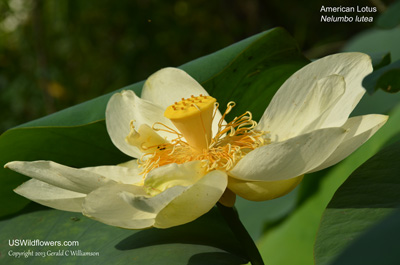
| | Site: Riverwalk, Amnicola Marsh, Hamilton County, TN Date: 2013-July-15 | Photographer: Gerald C Williamson
Nikon D7000 | | The receptacle can be nearly 3 inches across. Each of those protrusions is a pistil embedded in the flattened top of the receptable, and will form a nut-like seed. | | Click on the photo for a larger image
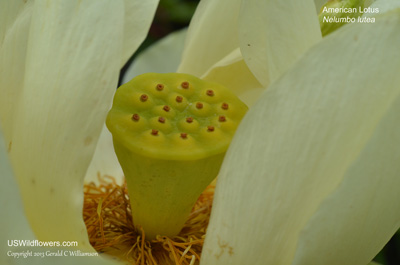
| | Site: Riverwalk, Amnicola Marsh, Hamilton County, TN Date: 2013-July-16 | Photographer: Gerald C Williamson
Nikon D7000 | | Nelumbo lutea is an aquatic plant, growing in ponds and marshes which have water year-round. It sometimes shares habitat with - Swamp Rose - a wild rose of wetlands which can also grow in shallow standing water. Here you see the rose hips of Swamp Rose below the blossom of American Lotus. | | Click on the photo for a larger image
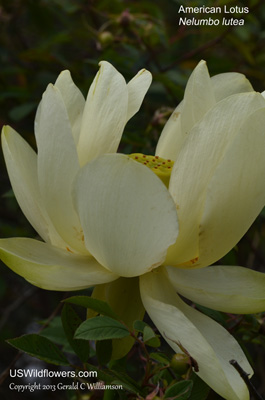
| | Site: Riverwalk, Amnicola Marsh, Hamilton County, TN Date: 2013-July-15 | Photographer: Gerald C Williamson
Nikon D7000 | | American Lotus can grow in large colonies, causing some to consider the plant "weedy" in areas where they want the waterway to remain open. The tepals of the flowers are such a pale yellow as to appear white when seen in contrast to the dark green leaves above which they are held. | | Click on the photo for a larger image
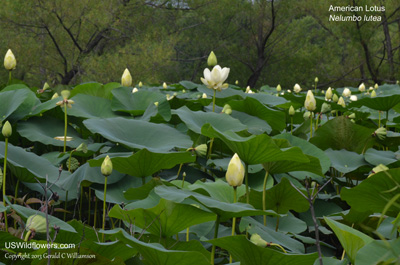
| | Site: Riverwalk, Amnicola Marsh, Hamilton County, TN Date: 2013-June-22 | Photographer: Gerald C Williamson
Nikon D7000
Tamron SP 90MM f/2.8 AF Macro | | The leaves of American Lotus may be held above the water, or may float on top of it. There is a report that Nelumbo nucifera (Sacred Lotus, not native to the United States) channels pressurized air down thru the petioles, which may explain the flotation. That pressurized air is vented thru the stomata in the center of the leaf. I assume that American Lotus does the same. The leaves can be up to about 2 feet in diameter, attaching to the petiole at the center. The petiole can be over 6 feet long, allowing it to grow in moderatly deep water. Notice that water beads up on the surface of the leaf. | | Click on the photo for a larger image
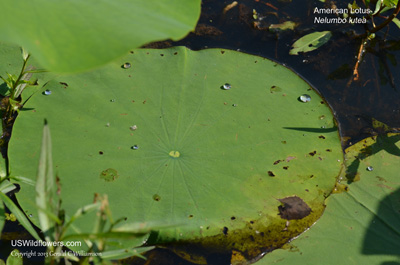
| | Site: Riverwalk, Amnicola Marsh, Hamilton County, TN Date: 2013-July-16 | Photographer: Gerald C Williamson
Nikon D7000 | | While held upright initially, the seedpod starts nodding toward the surface by the time the flower has dropped its tepals. | | Click on the photo for a larger image
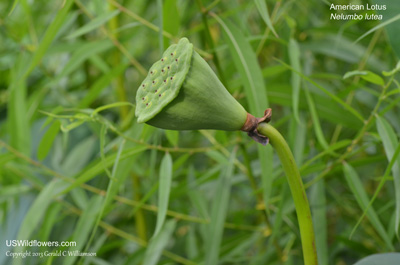
| | Site: Riverwalk, Amnicola Marsh, Hamilton County, TN Date: 2013-January-11 | Photographer: Gerald C Williamson
Nikon D7000 | | Native Americans ate the nut-like seeds and the plant tubers. | | Click on the photo for a larger image
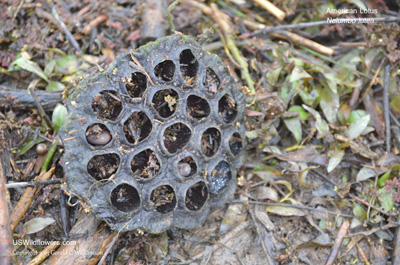
| | Site: Riverwalk, Amnicola Marsh, Hamilton County, TN Date: 2013-January-12 | Photographer: Gerald C Williamson
Nikon D7000 | | Modern Americans use the seed pods in floral decorations. While held upright initially, it nods toward the water surface at maturity. | | Click on the photo for a larger image
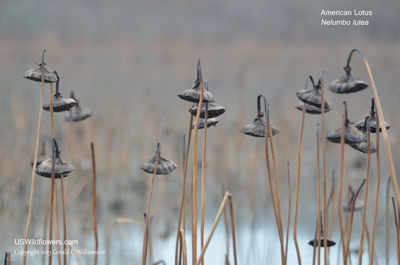
|
References used for identification and information:
|
|
| |
| #ad
|
|











